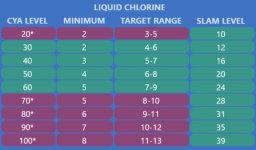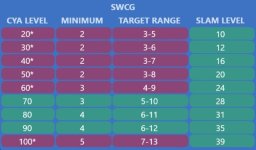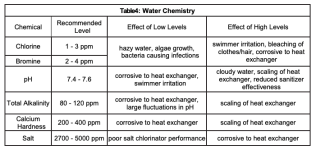I've been stuck for the past couple of days trying to figure this out.
I use a proper test kit to test levels and all other levels check out. I also use my local pool shop to test when my CYA drops below 30 since this can't be tested in the liquid Taylor kit that I use (if I assume 0, then I end up overdosing). My kids displace a lot of water when playing (they create "waves" that splash over) so I have to sometimes get tested after that (it's only reason I can figure why CYA would fall).
Since pool start up over 2 years ago, it's largely been incident free. I sometimes have a lot of demand, but usually in the summer. When I haven't been able to get chlorine to stick, it's always been dirty filters or a algae bloom that's in process of getting knocked out.
Latest measurements (from a Leslie's disc test because chlorine doesn't show up on the Taylor liquid drip test):
Free CL 0.32
Total CL 0.59
pH 7.4 * (precisely matches my test precisely)
Total Alk 107
Calcium 266
CYA 41 * (approximately matches my test, since the Taylor test is more of a range when outside of a specific value)
Iron 0.1
Copper 0.1
Phosphates 3704
TDS 2700
About 5 days ago I added calcium because my levels were low (<200). That spiked my pH to 7.8, which I dropped back down to 7.4 a couple of days later. Since the addition of calcium I've not been able to get chlorine to stick. I've used multiple gallons of 12.5% liquid chlorine over the past 3 days and it's like nothing was added (test wise). I've dosed to get to even 6 FC and it never even gets there.
I only use liquid chlorine, I don't use pucks, and I don't use shock.
As you might imagine, Leslie's is suggesting I do a partial drain to solve for the high Phosphates and TDS. I've always had high phosphates (it cycles, but out the tap it's always 200 or higher). TDS is usually high as well, somewhere between 1000-2700 based on my logs. I usually ignore both and I haven't had to drain before.
I have noticed for this pool season I've had to add chlorine on a more regular basis than previous years. It could be just a warmer season or the slightly smaller (but properly sized) filter system I installed earlier this year which seems to require more cleaning than before. The pool typically gets to 80º on its own, and when the heat pump is turned on, it can get up to 85º or higher. Since adding the calcium, I haven't been using the heater.
I had a big argument with the wife (the former steward of the pool) about draining because she says it's nonsense. But I don't know where else to begin! I'm a follower of the Pool School and I even looked at other threads to see if there are any clues. But in most cases those individuals had high CYA.
Are there any suggestions to solve this? Is this the one time that calls for a partial drain? We're loathe to do so, but I will if that's what it takes.
I use a proper test kit to test levels and all other levels check out. I also use my local pool shop to test when my CYA drops below 30 since this can't be tested in the liquid Taylor kit that I use (if I assume 0, then I end up overdosing). My kids displace a lot of water when playing (they create "waves" that splash over) so I have to sometimes get tested after that (it's only reason I can figure why CYA would fall).
Since pool start up over 2 years ago, it's largely been incident free. I sometimes have a lot of demand, but usually in the summer. When I haven't been able to get chlorine to stick, it's always been dirty filters or a algae bloom that's in process of getting knocked out.
Latest measurements (from a Leslie's disc test because chlorine doesn't show up on the Taylor liquid drip test):
Free CL 0.32
Total CL 0.59
pH 7.4 * (precisely matches my test precisely)
Total Alk 107
Calcium 266
CYA 41 * (approximately matches my test, since the Taylor test is more of a range when outside of a specific value)
Iron 0.1
Copper 0.1
Phosphates 3704
TDS 2700
About 5 days ago I added calcium because my levels were low (<200). That spiked my pH to 7.8, which I dropped back down to 7.4 a couple of days later. Since the addition of calcium I've not been able to get chlorine to stick. I've used multiple gallons of 12.5% liquid chlorine over the past 3 days and it's like nothing was added (test wise). I've dosed to get to even 6 FC and it never even gets there.
I only use liquid chlorine, I don't use pucks, and I don't use shock.
As you might imagine, Leslie's is suggesting I do a partial drain to solve for the high Phosphates and TDS. I've always had high phosphates (it cycles, but out the tap it's always 200 or higher). TDS is usually high as well, somewhere between 1000-2700 based on my logs. I usually ignore both and I haven't had to drain before.
I have noticed for this pool season I've had to add chlorine on a more regular basis than previous years. It could be just a warmer season or the slightly smaller (but properly sized) filter system I installed earlier this year which seems to require more cleaning than before. The pool typically gets to 80º on its own, and when the heat pump is turned on, it can get up to 85º or higher. Since adding the calcium, I haven't been using the heater.
I had a big argument with the wife (the former steward of the pool) about draining because she says it's nonsense. But I don't know where else to begin! I'm a follower of the Pool School and I even looked at other threads to see if there are any clues. But in most cases those individuals had high CYA.
Are there any suggestions to solve this? Is this the one time that calls for a partial drain? We're loathe to do so, but I will if that's what it takes.
Last edited:





